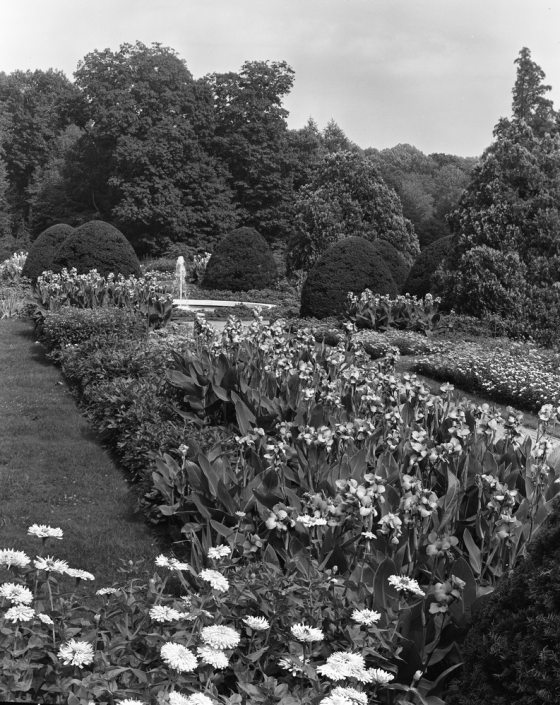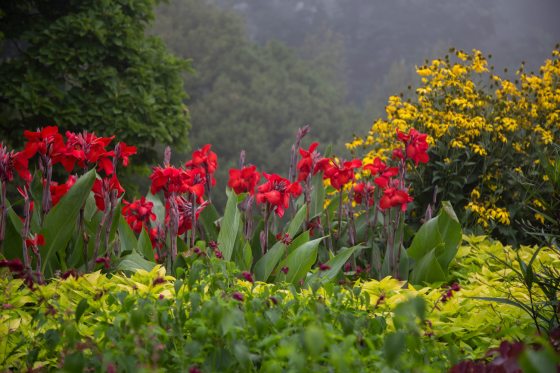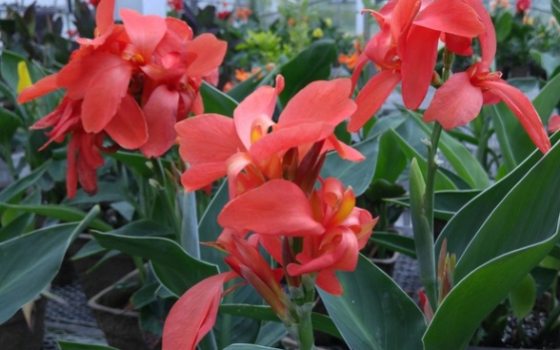Our canna breeding program is one of the longest tenured research programs at Longwood Gardens. Cannas became popular during the Victorian era as bedding plants, prized for their dramatic stature and summer flowers, primarily in shades of red, yellow, and orange. Like other popular plants of that era, they fell out of favor in later years.
During the 1960s, the staff at Longwood Gardens became interested in introducing cannas to our Conservatory and outdoor displays, and assembled a collection of cultivars that were commercially available at the time. It soon became obvious that none were up to the high standards of Longwood’s world-class displays, so in 1967 Longwood Geneticist Dr. Robert Armstrong initiated a breeding program to create canna hybrids that would suit the needs of our Gardens.
Germplasm for the breeding program was obtained from public gardens all over the world, and from wild populations in Central and South America and the West Indies. The original goal of the program was to breed yellow-flowered plants, but acquisition of seedlings bearing a range of flower colors resulted in expanding our program to create hybrids with a variety of colors.

Additional goals were to produce superior bedding plants with a dwarf, or reduced habit, and abundant flowers throughout the summer that were borne on open spikes. Another goal was self-cleaning of the spent flowers, but breeding for this habit proved to be difficult and resulted in plants with flowers that dropped early or flowers that were easily detached in wind and rain. The program branched in a new direction when the aquatic species, Canna glauca, obtained from famed Landscape Architect Roberto Burle Marx, led to experimental breeding of cannas that could lend a new dynamic to our aquatic landscapes.
During the course of our breeding program, thousands of crosses were made and thousands of progeny evaluated. Ultimately the work resulted in the naming and release of twelve terrestrial and four aquatic cultivars to dozens of public gardens and commercial nurseries.
All terrestrial cultivars were named for historic places and events within the vicinity of Longwood Gardens: ‘Brandywine’, ‘Chesapeake’, ‘Conestoga’, ‘Constitution’, ‘Declaration’, ‘Delaware’, ‘Franklin’, ‘Freedom’, ‘Independence’, ‘Lenape’, ‘Liberty’, and ‘Penn’. These selections are vigorous and of short to medium height; flowers come in a variety of colors produced throughout the summer; nearly all plants have green foliage with a translucent margin; and a few have the self-cleaning habit.
The four aquatic cultivars are: ‘Endeavor’, ‘Erebus’, ‘Ra’, and ‘Taney’. Aquatic cannas are larger in stature than terrestrial types, and are less adaptable to gardens in general because they must grow in standing water or be submerged in water gardens. However, they are still widely used in the lily pools at Longwood and complement our water lily and Victoria displays during the summer months.
Despite the longevity and success of the program, there is more to the story of breeding canna. When these cultivars were released, the nursery industry favored plants that could be propagated by division. But most, if not all, commercial canna stocks became infected by virus, including the Longwood Gardens selections. Though the cause is up for debate, this forced the industry to reevaluate how cannas are grown and propagated, resulting in a steady switch to cannas grown from seed.

Recognizing the value of the Longwood cultivars, our research staff conserved the Longwood canna selections by devising a method to eliminate virus from stock plants. Through a process called meristem isolation, researchers established virus-free stocks of cannas in tissue culture that could then be used to grow virus-free stocks in our production greenhouses. This method proved to be successful, and now virus-free stock is produced for displays on a yearly basis using plants grown in tissue culture.
This conservation effort also led to the revitalization of our breeding program. In 2009, a round of open-pollinated seed harvested from an outplanting of Longwood cultivars resulted in several new and promising seedlings that we singled out for further evaluation.
In spring 2016, another Longwood introduction hit the market—‘Longwood Simply Salmon’. This short-statured selection produces bright, salmon-colored flowers atop clean, green foliage throughout the summer, and is great as a patio container plant. Although initially distributed on a limited basis, it will be more widely available as of 2017.
Our canna breeding program continues to produce and evaluate new selections. We are now implementing strategies to develop new foliage forms of cannas, and growing more seedlings in the search for novel flower color, forms, and overall improved plants.
From Our Blog
-
"Canna" We Save the Canna???

Blog
"Canna" We Save the Canna???
Our cannas are being threatened! Plants all around the world are being infected by viruses that can affect the beauty of the plants and can eventually lead to death. Well, don’t panic because here at Longwood we have some projects underway that will hopefully give new life to the beautiful canna!
-
Introducing Canna ‘Longwood Simply Salmon’!

Blog
Introducing Canna ‘Longwood Simply Salmon’!
Our plant family is welcoming a new addition this summer: Canna ‘Longwood Simply Salmon’! This canna was bred here at Longwood and is being released commercially under the Longwood Gardens name.